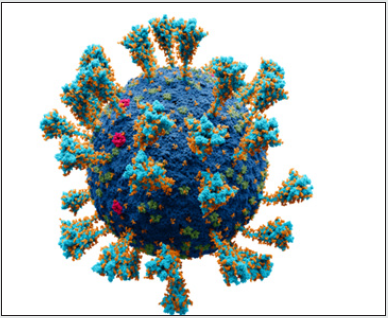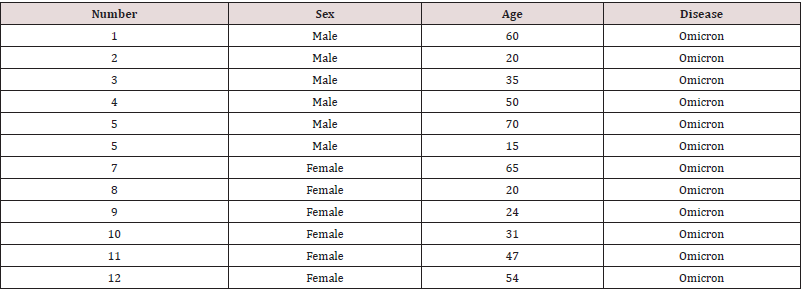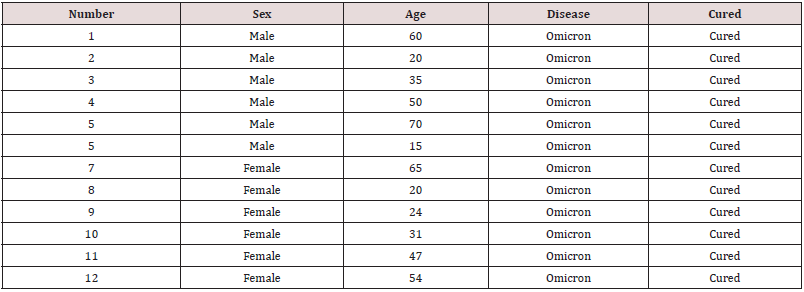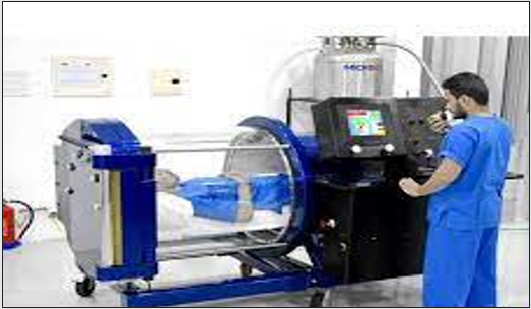
Lupine Publishers Group
Lupine Publishers
Menu
ISSN: 2637-6679
Review Article(ISSN: 2637-6679) 
On the Treatment of Sars-Cov-2 Including Omicron Type Volume 7 - Issue 2
Sorush Niknamian1*, Somayeh Zaminpira2
- 1Military Medicine Dep, Liberty University, Lynchburg, VA, USA
- 2American Beirut University, Lebanon
Received: January 24, 2022 Published: January 28, 2022
Corresponding author: Sorush Niknamian, Military Medicine Dep, Liberty University, Lynchburg, VA, USA
DOI: 10.32474/RRHOAJ.2022.07.000263
Abstract
Objective: The aim of this research is to introduce new method of the treatment/control of Omicron Virus and answer some
major questions regarding the cure of COVID-19 and the new type: Omicron.
Background: We have selected 24 patients (12 females plus 12 males) aged from 15-64 years of old contaminated severe
Omicron virus and used the novel methods on the treatment of these patients.
Introduction: The Omicron variant (B.1.1.529) is a variant of SARS-CoV-2 which was first reported to the World Health
Organization (WHO) from South Africa on 24 November 2021. Omicron multiplies around 70 times faster than the Delta variant
in the bronchi, but some evidence suggests that it is less severe than previous strains, specifically compared to the Delta variant.
Omicron might be less able to penetrate deep lung tissue. Omicron infections are 91 percent less fatal than the delta variant, with
51 percent less risk of hospitalization.
Materials and Methods: The Omicron virus has strongly high rate of mutation compared with other kinds of Coronaviruses
and therefore, cause severe symptoms of inflammation in the patients including lungs. In our research, all the patients were under
unique control. They received HBO2T with 2% Ozone mixture with Oxygen in special cube. Also, they had an injection of liquid
ozone which dramatically decline the inflammation in all tissues. They had under strict diet of special Ketogenic diet to maintain
their mitochondria to remain high metabolism to hamper the fatigue and tiredness. The had also gain supplements necessary for
the disease.
Results: all the patient showed full recovery in 3 days, but they had fatigue and tiredness which we had to give them MTC oil
30 grams/day and coconut oil 30 grams/day as well which reduced the tiredness of the patients dramatically and remain their
metabolism in a normal state. As a whole, all the patients recovered in 7 days without any symptoms including coughing, tiredness,
fever and etc.
Conclusion: Using the novel methodology of the treatment of SARS-CoV including Omicron had positive results on the patients.
HBO2T plus specific Ozone therapy dramatically reduced the inflammation in all tissues of the patients. This novel method is a
breakthrough in the science of Infectious Diseases including Omicron virus.
Keywords: Omicron Virus; SARS-CoV-2; MTC Oil; Ketogenic Diet; Ozone Therapy; HBO2T Therapy
Introduction
The most recent common ancestor (MRCA) of all coronaviruses has been placed at around 8000 BCE. [1] The MRCAs of the Alphacoronavirus line has been placed at about 2400 BCE, the Betacoronavirus line at 3300 BCE, the Gamma-coronavirus line at 2800 BCE, and the Delta coronavirus line at about 3000 BCE. It appears that bats and birds, as warm-blooded flying vertebrates, are ideal hosts for the coronavirus gene source (with bats for Alpha-coronavirus and Betacoronavirus, and birds for Gammacoronavirus and Delta-coronavirus) to fuel coronavirus. evolution and dissemination. [2] Bovine coronavirus and canine respiratory coronaviruses diverged from a common ancestor in 1951. [3] Bovine coronavirus and human coronavirus OC43 diverged around the 1890s. Bovine coronavirus diverged from the equine coronavirus species at the end of the 18th century. [4] The MRCA of human coronavirus OC43 has been dated to the 1950s. [5] MERSCoV, although related to several bat coronavirus species, appears to have diverged from these several centuries ago. [6] The human coronavirus NL63 and a bat coronavirus shared an MRCA 563–822 years ago. [7] The most closely related bat coronavirus and SARSCoV- 2 diverged in 1986. [8] A path of evolution of the SARS virus and keen relationship with bats have been proposed. The coronaviruses have been coevolved with bats for a long time and the ancestors of SARS-CoV first infected the species of the genus Hipposideridae, subsequently spread to species of the Rhinolophidae and then to civets, and finally to humans. [9,10] Alpaca coronavirus and human coronavirus 229E diverged before 1960. [11,12] The information above demonstrates that even 8000 years ago and so on, all the kinds of COVID-19 existed, Alpha, Beta, Gamma and even Delta kinds of this disease existed, and it is not a novel or new infectious disease we are fighting against (Figures 1 & 2). Drift and also Reassortment plays vital role in mutations and adaptation of COVID-19 specially Omicron which is nowadays contaminated high amounts of people and will be present in the future (Tables 1 & 2).
Figure 2: Illustration of the locations of the Omicron mutations in the spike protein, top Left picture and right picture, showing amino acid substitutions which has shown in color yellow, deletions (red), and insertions (green). In this trimeric structure, two monomers (gray and light blue) have their receptor-binding domains in the down conformation while one (dark blue) is in the up or open conformation. Mutation data from WHO, [11] structure from PDB: 6VYB [12].
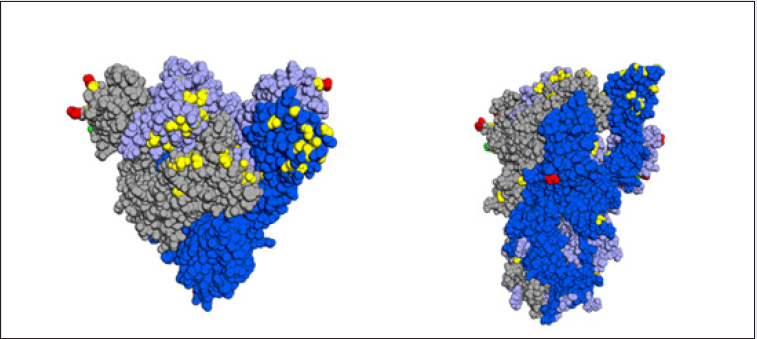
Materials and Methods
Since the Omicron virus has strongly high rate of mutation compared with other kinds of Coronaviruses and therefore cause severe symptoms of inflammation in the patients including lungs as we observed in 2 of our patients with high age. In our research, all the patients were under unique control, and it was a controlled study. They received HBO2T with 2% Ozone mixture with Oxygen in special cube. Also, they had an injection of liquid ozone which dramatically decline the inflammation in all tissues. They had under strict diet of special Ketogenic diet to maintain their mitochondria to remain high metabolism to hamper the fatigue and tiredness (Figures 3 & 4). The had also gain supplements necessary for the disease. The Ketogenic diet we used was 60% fat and 40% high fiber carbohydrates. They had Amino Acid 10% Serum once a day in the morning not to destroy the and diminish the muscles in their body and also maintain their dosage of amino acid since they did not have appetite to eat regularly. Plus, they had Dextrose/salt 9% serum with B-Complex, special Neurobion and Vitamin C injected into their serum once a day in the evening. Their supplements included 1200 mg of NAC, 30 mg Zinc Oxide, Vitamin b6 40 mg, Vitamin B1 100mg every night after their meal. We gave them 500mg vitamin c every two hours to maintain their blood of vitamin C levels to decrease the inflammation as well. Medical ozone is produced in varying concentrations. The quantity of ozone in comparison with the quantity of oxygen in the gas stream is called percent concentration. It is measured in micro grams (ug) of ozone per milliliter (or cc) of the mixture. A liter of oxygen weights 1.4 grams. Therefore; 0.5% x 1.4 gm = 7 ug/cc, 1.0% x 1.4 gm = 14 ug/cc, 1.5 x 1.4 gm = 21 ug/cc, 2.0% x 1.4 gm = 28 ug/cc, 2.5% x 1.4 gm = 35 ug/cc, 3.0% x 1.4 gm = 42 ug/cc, 3.5% x 1.4 gm = 49 ug/ cc, 4.0% x 1.4 gm = 56 ug/cc, 4.5% x 1.4gm = 63 ug/cc, 5.0% x 1.4 gm = 70 ug/cc [13]. 5% or 70 ug/cc is considered to be the upper limit of the concentration for the internal use of medical ozone. The medical internal ozone therapy in Omicron or Covid-19 treatment [14]. We used the average concentration means 21 ug/cc. This method of Ozone Therapy with liquid ozone injection, higher the blood flow through the body, decrease inflammation in the whole body, decrease inflammation in lungs dramatically and the most important which we also intrigued by was that this method stopped the virus activation in the tissues and the body.
Results
All the patients of any age showed in the table got treatment in three days. After 6 days all the side effects of Omicron virus diminished. They regain their strength and their weaknesses, muscle pain, tiredness, joint pain and bone pain went away. We call this novel protocol: Sorush Covid-19 Treatment Protocol. Although it needs some more research in this field and protocol, but it is a huge breakthrough in Covid control and treatment.
Conclusion
Using the novel methodology of the treatment of SARS-CoV including Omicron had positive results on the patients. HBO2T plus specific Ozone therapy dramatically reduced the inflammation in all tissues of the patients. This novel method is a breakthrough in the science of Infectious Diseases including Omicron virus. All the patients of any age showed in the table got treatment in three days. After 6 days all the side effects of Omicron virus diminished. They regain their strength and their weaknesses, muscle pain, tiredness, joint pain and bone pain went away. We call this novel protocol: Sorush Covid-19 Treatment Protocol. Although it needs some more research in this field and protocol, but it is a huge breakthrough in Covid control and treatment.
Acknowledgement
We would like to thank the US Department of Defense, American Beirut University, Sen. Mark R. Warner, Sen. Kaine and Representative Ben Cline for their encouragement in our research. Also, we would like to specifically thank Professor Stephanie Seneff PhD from Massachusetts Institute of Technology and Professor Thomas N Seyfried who always encouraged and motivated me.
References
- Sexton NR, Smith EC, Blanc H, Vignuzzi M, Peersen OB, Denison MR (2016) Homology-Based Identification of a Mutation in the Coronavirus RNA-Dependent RNA Polymerase That Confers Resistance to Multiple Mutagens. Journal of Virology 90(16): 7415-7428.
- Wertheim JO, Chu DK, Peiris JS, Kosakovsky Pond SL, Poon LL (2013) A case for the ancient origin of coronaviruses. Journal of Virology 87 (12): 7039-45.
- Woo PC, Lau SK, Lam CS, Lau CC, Tsang AK, Lau JH, et al. (2012) cDiscovery of seven novel Mammalian and avian coronaviruses in the genus deltacoronavirus supports bat coronaviruses as the gene source of alphacoronavirus and betacoronavirus and avian coronaviruses as the gene source of gammacoronavirus and deltacoronavirus. Journal of Virology 86 (7): 3995-4008.
- Bidokhti MR, Tråvén M, Krishna NK, Munir M, Belák S, Alenius S, Cortey M (2013) Evolutionary dynamics of bovine coronaviruses: natural selection pattern of the spike gene implies adaptive evolution of the strains. The Journal of General Virology. 94: 2036-2049.
- Vijgen L, Keyaerts E, Moës E, Thoelen I, Wollants E, Lemey P, et al. (2005) Complete genomic sequence of human coronavirus OC43: molecular clock analysis suggests a relatively recent zoonotic coronavirus transmission event. Journal of Virology 79 (3): 1595-15604.
- Lau SK, Lee P, Tsang AK, Yip CC, Tse H, Lee RA, et al. (2011) Molecular epidemiology of human coronavirus OC43 reveals evolution of different genotypes over time and recent emergence of a novel genotype due to natural recombination. Journal of Virology 85 (21): 11325-37.
- Lau SK, Li KS, Tsang AK, Lam CS, Ahmed S, Chen H, et al. (2013) Genetic characterization of Betacoronavirus lineage C viruses in bats reveals marked sequence divergence in the spike protein of pipistrellus bat coronavirus HKU5 in Japanese pipistrelle: implications forthe origin of the novel Middle East respiratory syndrome coronavirus. Journal of Virology 87 (15): 8638-50.
- Huynh J, Li S, Yount B, Smith A, Sturges L, Olsen JC, et al. (2012) Evidence supporting a zoonotic origin of human coronavirus strain NL63. Journal of Virology 86 (23): 12816-12825.
- Vijaykrishna D, Smith GJ, Zhang JX, Peiris JS, Chen H, Guan Y (2007) Evolutionary insights into the ecology of coronaviruses. Journal of Virology 81 (8): 4012-4020.
- Gouilh, Meriadeg Ar, Puechmaille, Sébastien J Gonzalez, Jean Paul, Teeling, et al. (2011) SARS-Coronavirus ancestor's footprints in South-East Asian bat colonies and the refuge theory. Infection, Genetics and Evolution 11(7): 1690-1702.
- Cui J, Han N, Streicker D, Li G, Tang X, Shi Z, et al. (2007) Evolutionary relationships between bat coronaviruses and their hosts. Emerging Infectious Diseases 13(10): 1526-1532.
- Classification of Omicron (2021) SARS-CoV-2 Variant of Concern World Health Organization. Archived from the original.
- Walls AC, Park YJ, Tortorici MA, Wall A, McGuire AT, Veesler D (2020) Structure, Function, and Antigenicity of the SARS-CoV-2 Spike Glycoprotein. Cell 181(2): 281-292.
- Niknamian S, Zaminpira S, Seneff S, Seyfried TN, Agostino DD, Gonzalez MJ (2019) Introducing the Sorush Cancer Treatment Protocol (SCTP). J Cancer Res Clin Pract 2(1): 110.

Top Editors
-

Mark E Smith
Bio chemistry
University of Texas Medical Branch, USA -

Lawrence A Presley
Department of Criminal Justice
Liberty University, USA -

Thomas W Miller
Department of Psychiatry
University of Kentucky, USA -

Gjumrakch Aliev
Department of Medicine
Gally International Biomedical Research & Consulting LLC, USA -

Christopher Bryant
Department of Urbanisation and Agricultural
Montreal university, USA -

Robert William Frare
Oral & Maxillofacial Pathology
New York University, USA -

Rudolph Modesto Navari
Gastroenterology and Hepatology
University of Alabama, UK -

Andrew Hague
Department of Medicine
Universities of Bradford, UK -

George Gregory Buttigieg
Maltese College of Obstetrics and Gynaecology, Europe -

Chen-Hsiung Yeh
Oncology
Circulogene Theranostics, England -
.png)
Emilio Bucio-Carrillo
Radiation Chemistry
National University of Mexico, USA -
.jpg)
Casey J Grenier
Analytical Chemistry
Wentworth Institute of Technology, USA -
Hany Atalah
Minimally Invasive Surgery
Mercer University school of Medicine, USA -

Abu-Hussein Muhamad
Pediatric Dentistry
University of Athens , Greece

The annual scholar awards from Lupine Publishers honor a selected number Read More...

.png)


